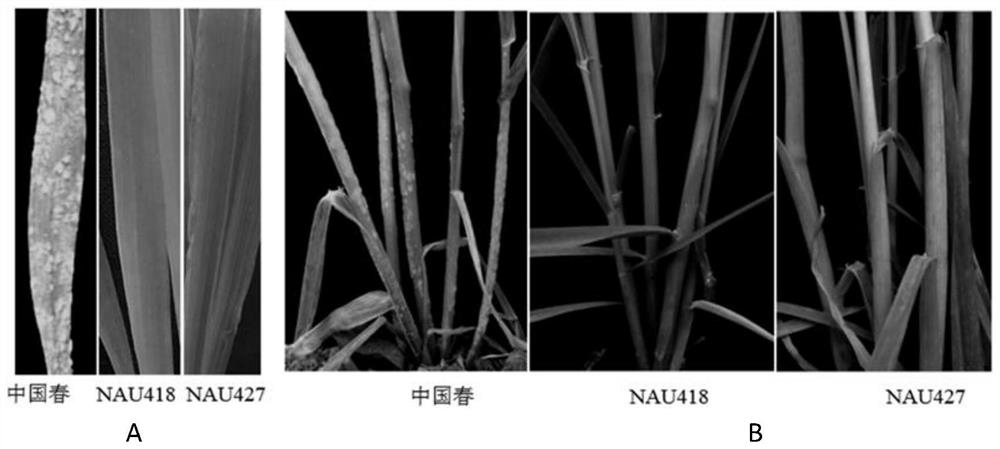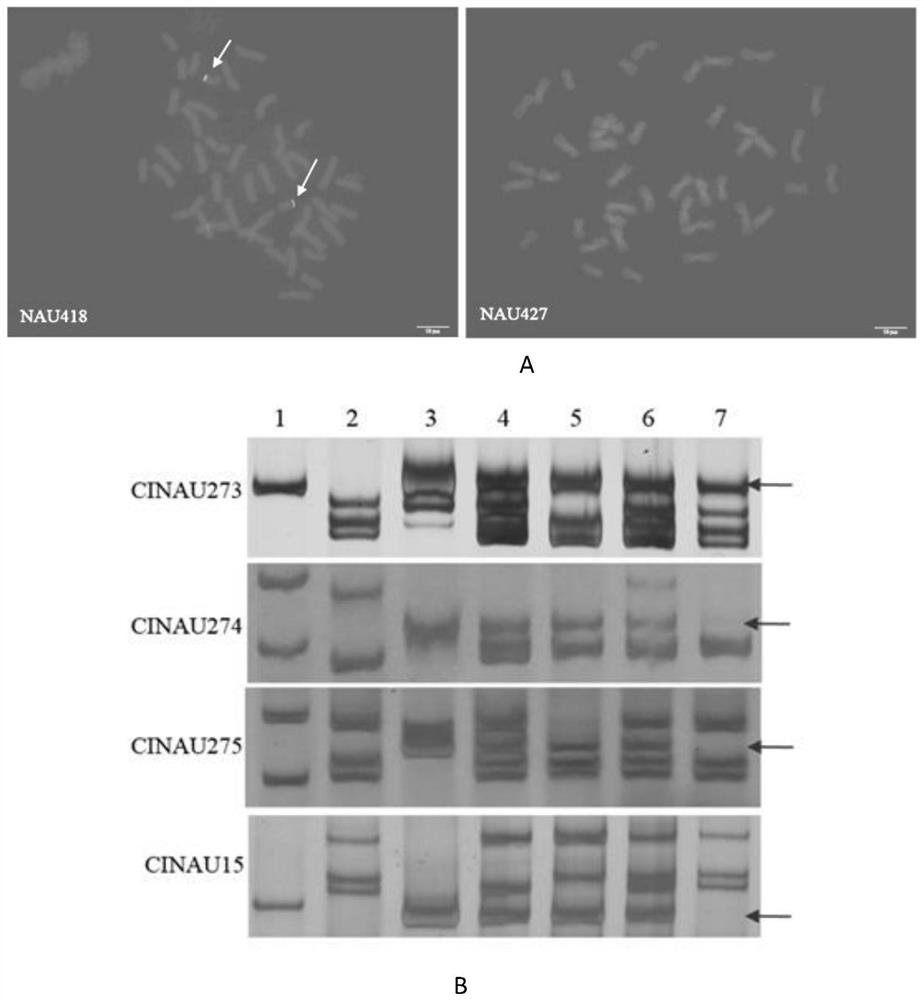Molecular marker linked to wheat disease resistance gene pm21 and its application in breeding
A disease-resistant gene and molecular marker technology, applied in the field of molecular genetic breeding, can solve problems such as easy loss of disease resistance, achieve convenient and rapid identification, and improve efficiency
- Summary
- Abstract
- Description
- Claims
- Application Information
AI Technical Summary
Problems solved by technology
Method used
Image
Examples
Embodiment 1
[0026] Example 1. Creation of the wheat-T. villosa minimal fragment translocation line NAU427 carrying the Pm21 gene
[0027] (1) In Jiangsu Academy of Agricultural Sciences, 1600 doses of 60The ears of T6VS·6AL whole-arm translocation line 92R137 were irradiated with COγ-rays 2-3 days before flowering. The irradiated ears were emasculated on the same day, and pollinated with normal Chinese spring pollen 2-3 days later to obtain structural variation Body M1 (Chen PD, You CF, Hu Y, Chen SW, Zhou B, Cao AZ, Wang X (2013) Radiation-induced translocations with reduced Haynaldia villosa chromatin at the Pm21 locus for powdery mildew resistance in wheat. Mol Breed 31:477- 484:).
[0028] (2) The M1 seeds are planted in the field, and the powdery mildew inoculation identification is carried out at the seedling and adult plant stages, the plants with high resistance to wheat powdery mildew are screened, and the seeds are harvested at the mature stage.
[0029] (3) The root tips were...
Embodiment 2
[0032] Example 2. Analysis of the disease resistance effect of the wheat-T. villosa minimal fragment translocation line NAU427
[0033] (1) In order to analyze the disease resistance effect of the translocation fragments in the wheat-T. villosa translocation line NAU427, NAU427 was crossed with Shi 4185 and Yangmai 158, popular varieties susceptible to powdery mildew in different ecological zones, to obtain F1, and then The popularized varieties Shi 4185 and Yangmai 158 were used as recurrent parents for multiple backcrosses, and the disease resistance and molecular marker CINAU1704 were identified in each generation. In the backcross BC4 generation, the disease-resistant plants were self-crossed to harvest seeds BC4F1.
[0034] (2) Plant the selfed seeds in the plastic greenhouse of Jiangpu Farm, Nanjing Agricultural University, with a row length of 1.2m and a row spacing of 20cm, and 10 seeds are sown in each row, and the individual plants are identified for powdery mildew re...
Embodiment 3
[0037] Example 3. Development of Molecular Markers Linked to Pm21 in the Wheat-T. villosa Translocation Line NAU427 (1) Development of Molecular Markers Linked to Pm21 in NAU427
[0038] 1.1 Determination of the collinear segment of the introgressed T. villosa translocation segment with Brachypodium and rice
[0039] Both NAU418 and NAU427 contained the Pm21 gene, and the results of in situ hybridization showed that the translocation fragment of NAU418 was larger than that of NAU427. In order to develop molecular markers linked to the Pm21 gene in the NAU427 translocation fragment, the EST sequences of four markers CINAU273, CINAU274, CINAU275, and CINAU15, which amplified 6VS-specific bands in the small fragment translocation line NAU418, were first extracted. Compare these 4 EST sequences with the genome sequences of Brachypodium (http: / / plants.ensembl.org / Brachypodium_distachyon / Info / Index) and rice (http: / / plants.ensembl.org / Oryza_sativa / Info / Index) Comparison, the result...
PUM
 Login to View More
Login to View More Abstract
Description
Claims
Application Information
 Login to View More
Login to View More - R&D Engineer
- R&D Manager
- IP Professional
- Industry Leading Data Capabilities
- Powerful AI technology
- Patent DNA Extraction
Browse by: Latest US Patents, China's latest patents, Technical Efficacy Thesaurus, Application Domain, Technology Topic, Popular Technical Reports.
© 2024 PatSnap. All rights reserved.Legal|Privacy policy|Modern Slavery Act Transparency Statement|Sitemap|About US| Contact US: help@patsnap.com










